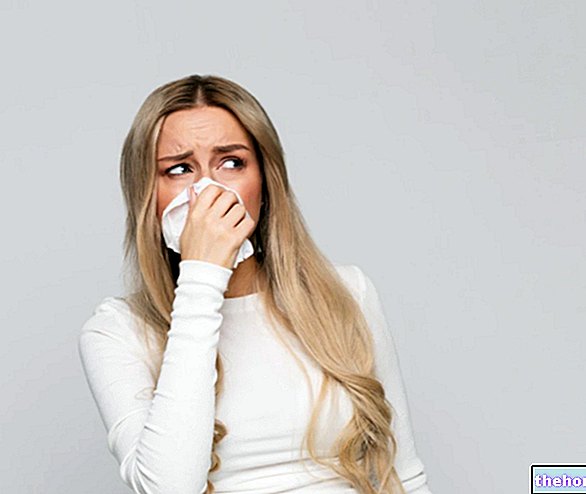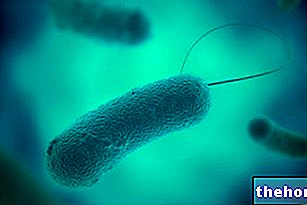Generality
The term rhinitis indicates a generic irritation and inflammation of the nasal mucosa.
There are three main types of rhinitis: infectious rhinitis, allergic rhinitis and non-allergic rhinitis (or vasomotor rhinitis).

The classic symptoms of a rhinitis are: stuffy nose, runny nose, repeated sneezing, postnasal drip (or discharge) and nasal voice.
For a correct diagnosis, you will need: physical examination, medical history, a series of allergy tests and a nasal swab.
The treatment of rhinitis varies according to the triggering causes.
What is Rhinitis?
Rhinitis is the medical term for any irritative and inflammatory process affecting the nasal mucosa.
According to the most widespread classification, which takes into account the triggering causes, there are three types of rhinitis: infectious rhinitis, non-allergic rhinitis (or vasomotor rhinitis) and allergic rhinitis.
Episodes of rhinitis are a fairly common problem.
WHAT IS NASAL MUCOSA?
Highly vascularized, the nasal mucosa is the particular epithelium that lines the nasal cavities and makes them moist, through the secretion of mucus. It has at least three functions:
- Helps to warm and humidify the air entering the nose;
- It traps the harmful (or in any case foreign) substances that could be found in the air entering the nose;
- It supports the sense of smell, as it has connections with the first cranial nerve (or olfactory nerve).
OTHER CLASSIFICATION OF RHINITIS: ACUTE AND CHRONIC FORMS
Depending on the rapidity of onset of symptoms and their severity, a rhinitis can be defined as acute or chronic (N.B: a synonym for chronic is permanent).
A rhinitis is acute, when the symptoms that characterize it appear quickly, last a few days and are very severe.
A rhinitis is chronic, however, when the clinical manifestations that characterize it appear gradually, last several weeks and are not particularly intense. To learn more, read: Chronic Rhinitis.
Causes
The three types of rhinitis mentioned above have different causes, therefore they deserve a case by case treatment.
ALLERGIC RHINITIS
Allergic rhinitis is the result of an allergic response to substances, such as pollen, dust, the so-called Balsam of Peru or animal hair.
From a pathophysiological point of view, in the presence of an allergic rhinitis it happens that the allergens (i.e. the aforementioned substances) induce the mast cells present in the nose to become the protagonists of an anomalous and massive degranulation, from which large quantities of inflammatory substances derive. A substance deriving from degranulation, particularly active in causing the inflammatory processes that characterize allergic rhinitis, is histamine.
According to some statistical surveys, which refer to the inhabitants of the United States, allergic rhinitis affects 10-30% of adults every year.
What is an allergy?
An "allergy can be defined as an exaggerated, inappropriate and harmful antibody response triggered by the immune system to substances (so-called allergens) which, for most people, are completely harmless
NON-ALLERGIC RHINITIS
At present there is little clarity on what the precise causes of non-allergic rhinitis are.
According to the most accredited medical hypotheses, the inflammatory process that characterizes vasomotor rhinitis would be initiated by an excessive dilation of the blood vessels of the nasal mucosa and the consequent accumulation, in the nasal cavities covered by the latter, of large quantities of blood and fluids.
Based on various scientific studies, some of the factors that seem capable of favoring, in still unclear circumstances, the aforementioned vasodilation process are:
- The high temperature, sudden changes in temperature, high humidity, exposure to toxic fumes (eg cigarette smoke), spicy foods, too hot foods, stress, alcoholic substances, intense perfumes, etc. All these factors are labeled with the term environmental factors;
- Hormonal imbalances, which characterize particular moments in the life of a human being, such as pregnancy (exclusively for women) or puberty;
- Hormonal therapies or hormonal contraceptives;
- Particular pharmacological substances, including: some NSAIDs (eg: ibuprofen or aspirin), beta-blockers, ACE inhibitors (or inhibitors of the angiotensin converting enzyme), nasal decongestants in the form of sprays (in these situations , we speak of medicamentous rhinitis), drugs for the treatment of erectile dysfunction and some tranquilizers (eg benzodiazepines);
- The presence of damage to the turbinates or the absence of the latter, for example due to surgical removal. The turbinates are specific areas of the nasal cavity, made up of tissues that have the task of humidifying the inside of the nose and preventing the entry into the body of bacterial agents and other potentially dangerous microorganisms.
Non-allergic rhinitis, which depends on damage to the turbinates or their absence, is also called atrophic rhinitis; - Intense physical exercise;
- Sexual arousal.
According to some interesting research conducted in the United States, non-allergic rhinitis affects about 17 million inhabitants and affects the 20-year-olds with a particular predilection.
Sometimes, non-allergic rhinitis can occur in association with allergic rhinitis. To identify these particular circumstances, doctors have adopted the term "mixed rhinitis".
INFECTIOUS RHINITIS
Infectious rhinitis is so called because it arises due to viral infections - that is, triggered by viruses - or bacterial - that is, induced by bacteria.
Viruses capable of causing rhinitis include:
- THE Rhinovirus;
- THE Coronavirus;
- The flu viruses;
- The Adenovirus;
- Human parainfluenza viruses;
- The Syncytial Respiratory Virus;
- The Enterovirus;
- THE Metapneumovirus;
- The measles virus.
Among the bacteria capable of causing rhinitis, they deserve a mention:
- Streptococcus pneumoniae;
- Haemophilus influenzae;
- Moraxella catarrhalis.
Symptoms, signs and complications
The classic symptoms of a rhinitis are: stuffy nose, runny nose, repeated sneezing, postnasal drip (or discharge) and nasal voice.
The presence of other disorders depends on the type of rhinitis.
Therefore, it can be concluded that the symptomatological picture of a rhinitis includes a series of generic clinical manifestations, independent of the type of rhinitis, and a series of specific clinical manifestations, dependent on the triggering causes.
SYMPTOMS OF ALLERGIC RHINITIS
The specific symptoms of allergic rhinitis are:
- Nasal itching;
- Cough;
- Headache;
- Sense of fatigue;
- Malaise;
- Itchy throat
- Conjunctivitis;
- Tearing
- Eyelid swelling (or swollen eyelids);
SYMPTOMS OF NON-ALLERGIC RHINITIS
The specific symptoms of non-allergic rhinitis consist of:
- Moderate irritation and discomfort in and around the nose
- Reduced sense of smell (anosmia);
- Formation of one or more scabs inside the nasal passages. These scabs can be responsible for a bad smell coming out of the nose and for bleeding (if you try to remove them);
- Snoring
- Halitosis.
If particularly severe or if not treated properly, non-allergic rhinitis can lead to a variety of complications, including: sleep disturbances, daytime sleepiness, irritability, concentration problems, nasal polyps, sinusitis and borne infections. of the middle ear.
SYMPTOMS OF INFECTIOUS RHINITIS
The specific symptoms of infectious rhinitis are:
- Fever;
- Cough;
- Halitosis;
- Tiredness;
- Malaise.
Failure to treat infectious rhinitis can cause the bacterium or virus responsible for the infection to reach the bronchi and / or lungs and cause pneumonia. Episodes of bacterial or viral pneumonia, therefore, are among the possible complications of infectious rhinitis.
Diagnosis
Typically, to diagnose rhinitis and understand its exact type, you will need: a physical examination, medical history, a series of allergy tests (skin tests and blood tests), and a nasal swab.
A positive response to allergic tests is indicative of allergic rhinitis; a negative answer, on the other hand, indicates a non-allergic or infectious rhinitis.
A positive response to the nasal swab is proof that the rhinitis is due to an infection; nasal swabs are tests that allow those who perform them to trace the triggering pathogen.
Knowledge of the precise causes of rhinitis is essential for planning the most appropriate therapy.
Treatment
The treatment of a rhinitis depends, first of all, on the triggering causes (therefore on the type of rhinitis) and, secondly, on the severity of the symptoms.
ALLERGIC RHINITIS
The most adopted therapy in case of allergic rhinitis includes:
- A series of precautions aimed at avoiding exposure to allergens triggering the symptoms;
- The administration of antihistamines in sprays, tablets or liquid solution. Antihistamine drugs are used to block the release of histamine, which, as readers will remember, is the substance responsible for inflammatory processes of an allergic nature;
- The use of decongestants that can be administered by spray or orally. Decongestants are useful for clearing a blocked nose.
They are contraindicated in case of hypertension and genitourinary diseases. They must not be used for long periods of time; - The use of eye drops and spray saline solutions. Eye drops are used to relieve itchy eyes, while spray saline solutions, on the other hand, are used to free the nose from excess mucus;
- Immunotherapy. Allergies are exaggerated responses of the immune system. Immunotherapy aims to reduce the strength of the immune system, so that the likelihood of an exaggerated response from the immune system to some type of allergen is less likely .
NON-ALLERGIC RHINITIS
The treatment of non-allergic rhinitis includes:
- A series of attentions aimed at avoiding direct contact with those factors that seem to induce the inflammatory process affecting the nasal mucosa;
- Nasal washes with saline solutions. They are used to cleanse the nasal cavities of excess mucus and irritants. In addition to reducing the inflammatory state, they are a source of relief;
- The use of corticosteroid nasal sprays. Corticosteroids are powerful anti-inflammatory drugs, which are medicines that reduce inflammation. Their prolonged use can lead to various side effects, therefore it is good to take them only after medical prescription;
- The use of anticholinergic nasal sprays. They limit the production of mucus inside the nasal cavities, thus relieving the symptom known as a runny nose;
- The use of decongestant nasal sprays. They reduce the excessive dilation of the blood vessels of the nasal mucosa.
INFECTIOUS RHINITIS
Treatment of infectious rhinitis depends on what the pathogen is.
If a bacterium is causing the rhinitis, doctors prescribe an ad hoc antibiotic therapy, combined with a rest period and the administration of anti-inflammatories against fever.
If, on the other hand, a virus is causing the rhinitis, doctors almost always avoid prescribing antiviral drugs and limit themselves to recommending a period of rest and the administration of anti-inflammatory drugs against the feverish state.
Prognosis
The prognosis for rhinitis depends on several factors, including:
- The curability of the triggering causes. A rhinitis with treatable causes will, for obvious reasons, have a better prognosis than a rhinitis with causes that are difficult to cure;
- The severity of the symptoms. A rhinitis that has given rise to complications will have a more frequently negative prognosis;
- The attention that the patient pays to avoid certain agents triggering the symptoms. This point is particularly valid in the case of allergic rhinitis and non-allergic rhinitis.
Prevention
The only truly preventable type of rhinitis is infectious rhinitis.
To prevent the latter, doctors consider two countermeasures to be fundamental: keep away from people with infectious rhinitis and get vaccinated against the viruses and bacteria responsible for infectious rhinitis.




























